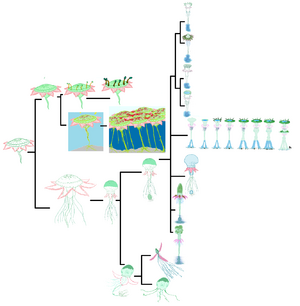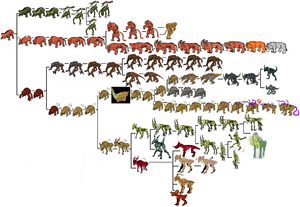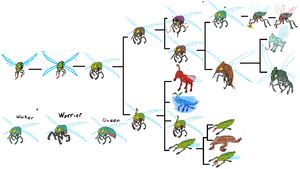Primordial Evolution Game/South Continent
Geography
Wildlife
Progenitors
Cave Bord:
Cave Fus"
Cave Hoppa:
Cave Raga: A fruiting plant that thrives in the dim light of shallow caves.
Cedya: A mushroom-like fungus that induces stomach pains when injested.
Emil: A luminescent descendant of the Lem'Uy. They are
Fren: A fern type plant adapted to living off the low light of near-surface caves and luminescent organisms.
Geist: A small, mammal-like predator. Being descended from Cidexes, they have no eyes.
Gesh: A close relative to the geist native to the plains and marshes. This predator has a strong jaw that can
Hamun: A shelled lithovore with tendrils which contain a symbiotic algae.
Hexis: A short tree that grows in a spiral and reproduces with spores.
Inoglund: A species of Glund that have adapted to the low light environment of the massive cavern system. Despite appearances, they are more bug-like than reptilian. They give live birth to larval young.
Lacorra: This sedentary creature makes hollow pipes made out of minerals it absorbed through the ground. It also has symbiosis with a plant, which grows in the pipes and supplies the creature with sugar. To complete its diet, it extends tentacles to grab flyers and plant spores. The tentacles also work in oxygen exchange.
Lub: Large jellyfish-like creatures that lives in a symbiotic relationship with algae under their skin. Species can be encountered in the lakes, rivers, marshes, and along the coast.
Puruu: A poisonous colonial organism made up of inumerable microscopic jellyfish-like creatures. Puruus live in the swamps and marshes.
Schwar: An amphibious scavenger descended from the bladeworem. They are mostly found near water.
Siwari: A grass with branching leaves that grows small fruits.
Thudder: A heavily armored herbivore that lives in the plains. Like their relative the Inoglund, they too give live birth to larval young.
Wirm: A small Sluck descendent.
Yazda: Small parastic bugs that drink blood and sap. They are encountered most often in the jungles, plains, and marshes.
Fauna
Cave Bord Evolution

Cave Fus Evolution

Cave Hoppa Evolution

Emil Evolution

Geist Evolution

Gesh Evlulution

Hamun Evolution

Inoglund Evolution

Lacorra Evolution

Lub Evolution

Puruu Evolution

Schwar Evolution

Thudder Evolution

Wirm Evolution

Yazda Evolution

Fungi and Flora
Cave Raga Evolution

Cedya Evolution

Fren Evolution

Hexis Evolution

Squat Hexis

Squat Hexis
Status: Extant
progenitor: Hexis
-> Methuselah Hexis
-> Shrub Hexis
These bushes grow in clearings in the forests, quickly spreading through them. It's common for insects to bore into these plants. Remarkably, this doesn't seem to bother the bush.
Methuselah Hexis

Methuselah Hexis
Status: Extant
progenitor: Squat Hexis
The Methuselah Hexis an especially durable plant which grows dry, rocky soil, and thin air of the high mountains. The shrub takes over a century to reach maturity. Upon reaching maturity, the Hexis produces a slow, but steady supply of asexual spores. As they often live for several millennia, a lot can happen to these large shrubs. The occasional landslide, fire, or even herbivore can cause a lot of damage to the plant. These hexises are excellent at storing energy for these events. While young and/or undisturbed, they have the typical helical form of the Hexis family. The older, battered plants appear more like a tangle of split, snapped, and possibly even scorched branches that recovered from the centuries of abuse they undergo. They store enough energy to spend the next few decades regrowing their branches if they are by chance all lost. Even though they grow slightly faster in lower altitudes, they aren't commonly found there. The more frequent presence of fauna keeps them from truly taking hold.
Shrub Hexis

Shrub Hexis
Status: Extinct
progenitor: Squat Hexis
-> Gildenthread Bush
The Shrub Hexis was a gnarly shrub that grew in the dry savahnnas of South Continent.
Gildenthread Bush

Gildenthread Bush
Status: Extant
progenitor: Shrub Hexis
s only a matter of time until many animals learned to instinctively avoid the carnivorous Whipping Hexis. Having trouble attracting prey, there was little choice but to actively to out on the hunt. Some of them become roaming predators, hunting down prey with a weak sense of smell and tremor sense. Roots atrophy, and another trunk is grown. The Hexis Shambler is now its name. The Gildenthread Bush produces spores which are covered in soft, silvery fluff. This fluff easily picks up in the wind and rips the spore out of it's base on the plant, sending it wherever the air current takes it. The thread is often silver in coloration, but in ideal conditions when the plant has plentiful sunlight, water, and minerals, the thread takes a brilliant golden sheen as it's laced with nutrients to help jumpstart the spore within.
The spore itself is fire resistant, the fluff covering providing useful food for the spore if it's set aflame during a fire. The golden variety of the spore is mildly fragrant, slightly sweet and catching to the eye, making it an attractive target for a grazing herbivore
Helix Hexis

Helix Hexis
Status: Extinct
progenitor: Hexis
-> Greater Hexis
-> Broadleaf Hexis
-> Pool Hexis
The Helix Hexis was a tree that towered above all other plants when they were around.
Great Hexis

Greater Hexis
Status: Extant
progenitor: Helix Hexis
The Great Hexis is the largest of all Hexis species. Compared to the Helix Hexis, they are 30-40% taller on average at their full height, putting them at around the height of Earth's pinus strobus. They make up the majority of trees deep in the jungle.
Broadleaf Hexis

Broadleaf Hexis
Status: Extant
progenitor: Helix Hexis
This species of Hexis is known for it's large leaves, which grow to about a meter in length. They grow in the rainforests to the north of the continent.
Pool Hexis

Pool Hexis
Status: Extinct
progenitor: Helix Hexis
-> Oasis Tree
-> Whipping Hexis
Some species of Hexis in the drier plains had pools of water laced with naturally produced glucose at their bases. Lining the edge of the water with their spores, the Hexis used these watering holes as a constant source of pollinators; everything from insects to animals would come from far and wide to get a drink.
The requirements to sustain this were taxing however, and because of this, the tree's roots had to grow further into the ground, tapping into the vast aquifers of the plains.
Oasis Tree

Oasis Tree
Status: Extant
progenitor: Pool Hexis
As a result of the plains becoming drier, the Pool Hexises became what is now knonw as the Oasis Tree. The Oasis Tree is a small tree adapted to conserving its water supply. The pools between their twisting trunks are smaller than what the Pool Hexis had, but are also more consentrated. Their waxy leaves aid in preventing loss of moisture. Massive, intricate system of roots support each plant with water and mineral absorbtion from the expansive underground aquifers of the South Continent. Vast stretches of the plains could be covered by an astonishingly small number of Oasis Trees. A covering over the pool forces animals to stick their heads in to drink, which effectively covers them in the plant's spores. Aided by the production of caffeine, animals get addicted to their nectar. This ensures that there are always creatures to spread their spores.
Whipping Hexis

Whipping Hexis
Status: Extinct
progenitor: Pool Hexis
-> Coiling Hexis
-> Shambler
The Whipping Hexis was a tree with more developed muscular tissues than most plants on Borgas IV. They were a species of carnivorous trees which lured in prey with a sweet scent similar to that of Oasis Trees. Root tips blending in with surrounding grasses would detect nearby animals, which the Hexis would then pummel into submission and stuff into its digestion cavity.
Coiling Hexis

Coiling Hexis
Status: Extant
progenitor: Whipping Hexis
Hexis Shambler

Hexis Shambler
Status: Extinct
progenitor: Hexis Shambler
-> Nimble Shambler
-> Bare Shambler
-> Ravenous Shambler
The Hexis Shambler (just Shambler for short) was a predatory tree. They'd track down prey by smell using the scent receptors on their root tips. Newly grown shamblers appeared as a normal hexis, but they'd eventually outgrow their roots and take up their predatory lifestyle.
Nimble Shambler

Nimlble Shambler
Status: Extant
progenitor: Hexis Shambler
The Nimble Shambler earn
Bare Shambler

Bare Shambler
Status: Extinct
progenitor: Hexis Shambler
-> Puppeteer Shambler
-> Lub Shambler
Puppeteer Shambler

Puppeteer Shambler
Status: Extant
progenitor: Bare Shambler
Lub Shambler

Lub Shambler
Status: Extant
progenitor: Bare Shambler
Ravenous Shambler

Ravenous Shambler
Status: Extant
progenitor: Hexis Shambler
-> Inverted Shambler
Inverted Shambler

Inverted Shambler
Status: Extant
progenitor: Ravenous Shambler
Among Shamblers, the Inverted Shambler is an oddity. It earns its name from when being compared to all other species of the genus, this one's usual position would be upside down.
Siwari Evolution
